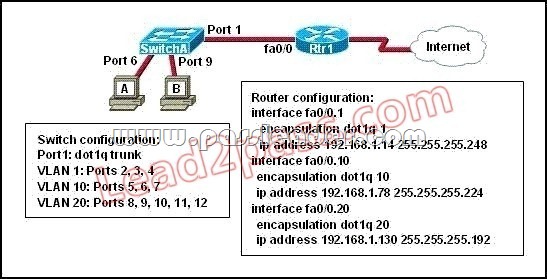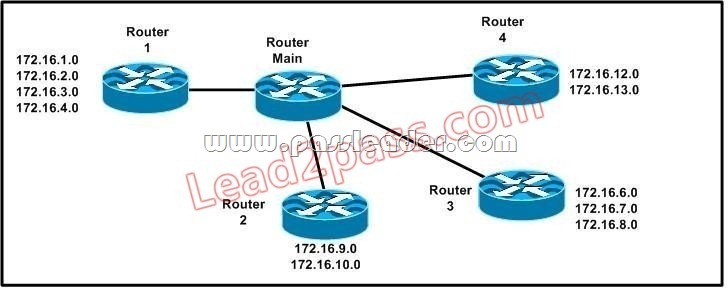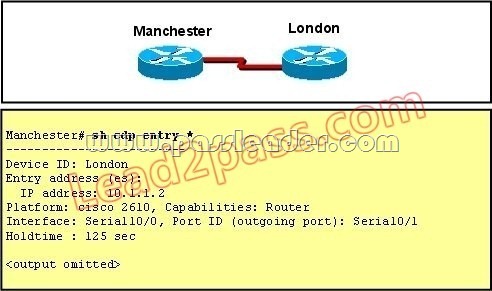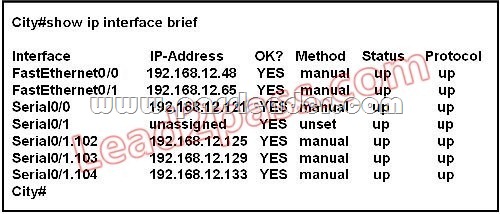New 200-125 exam questions from PassLeader 200-125 dumps! Welcome to download the newest PassLeader 200-125 VCE and PDF dumps: http://www.passleader.com/200-125.html (1196 Q&As –> 1275 Q&As –> 1331 Q&As –> 1351 Q&As)
P.S. Free 200-125 dumps are available on Google Drive shared by PassLeader: https://drive.google.com/open?id=0B-ob6L_QjGLpeHlmcExhU2FVY00
QUESTION 81
Which three are characteristics of an IPv6 anycast address? (Choose three.)
A. one-to-many communication model
B. one-to-nearest communication model
C. any-to-many communication model
D. a unique IPv6 address for each device in the group
E. the same address for multiple devices in the group
F. delivery of packets to the group interface that is closest to the sending device
Answer: BEF
Explanation:
A new address type made specifically for IPv6 is called the Anycast Address. These IPv6 addresses are global addresses, these addresses can be assigned to more than one interface unlike an IPv6 unicast address. Anycast is designed to send a packet to the nearest interface that is apart of that anycast group. The sender creates a packet and forwards the packet to the anycast address as the destination address which goes to the nearest router. The nearest router or interface is found by using the metric of a routing protocol currently running on the network. However in a LAN setting the nearest interface is found depending on the order the neighbors were learned. The anycast packet in a LAN setting forwards the packet to the neighbor it learned about first.
QUESTION 82
A national retail chain needs to design an IP addressing scheme to support a nationwide network. The company needs a minimum of 300 sub-networks and a maximum of 50 host addresses per subnet. Working with only one Class B address, which of the following subnet masks will support an appropriate addressing scheme? (Choose two.)
A. 255.255.255.0
B. 255.255.255.128
C. 255.255.252.0
D. 255.255.255.224
E. 255.255.255.192
F. 255.255.248.0
Answer: BE
Explanation:
Subnetting is used to break the network into smaller more efficient subnets to prevent excessive rates of Ethernet packet collision in a large network. Such subnets can be arranged hierarchically, with the organization’s network address space (see also Autonomous System) partitioned into a tree-like structure. Routers are used to manage traffic and constitute borders between subnets. A routing prefix is the sequence of leading bits of an IP address that precede the portion of the address used as host identifier. In IPv4 networks, the routing prefix is often expressed as a “subnet mask”, which is a bit mask covering the number of bits used in the prefix. An IPv4 subnet mask is frequently expressed in quad-dotted decimal representation, e.g., 255.255.255.0 is the subnet mask for the 192.168.1.0 network with a 24-bit routing prefix (192.168.1.0/24).
QUESTION 83
Refer to the exhibit. A network administrator is adding two new hosts to Switch A . Which three values could be used for the configuration of these hosts? (Choose three.)

A. host A IP address: 192.168.1.79
B. host A IP address: 192.168.1.64
C. host A default gateway: 192.168.1.78
D. host B IP address: 192.168.1.128
E. host B default gateway: 192.168.1.129
F. host B IP address: 192.168.1.190
Answer: ACF
QUESTION 84
Which IPv6 address is the all-router multicast group?
A. FF02::1
B. FF02::2
C. FF02::3
D. FF02::4
Answer: B
Explanation:
Well-known IPv6 multicast addresses:
Address
Description
ff02::1
All nodes on the local network segment
ff02::2
All routers on the local network segment
QUESTION 85
Refer to the exhibit. Which address range efficiently summarizes the routing table of the addresses for router Main?

A. 172.16.0.0./21
B. 172.16.0.0./20
C. 172.16.0.0./16
D. 172.16.0.0/18
Answer: B
Explanation:
The 172.16.0.0./20 network is the best option as it includes all networks from 172.16.0.0 – 172.16.16.0 and does it more efficiently than the /16 and /18 subnets. The /21 subnet will not include all the other subnets in this one single summarized address.
QUESTION 86
Which IPv6 address is valid?
A. 2001:0db8:0000:130F:0000:0000:08GC:140B
B. 2001:0db8:0:130H::87C:140B
C. 2031::130F::9C0:876A:130B
D. 2031:0:130F::9C0:876A:130B
Answer: D
Explanation:
An IPv6 address is represented as eight groups of four hexadecimal digits, each group representing 16 bits (two octets). The groups are separated by colons (:). An example of an IPv6 address is 2001:0db8:85a3:0000:0000:8a2e:0370:7334. The leading 0’s in a group can be collapsed using ::, but this can only be done once in an IP address.
QUESTION 87
Which command can you use to manually assign a static IPv6 address to a router interface?
A. ipv6 autoconfig 2001:db8:2222:7272::72/64
B. ipv6 address 2001:db8:2222:7272::72/64
C. ipv6 address PREFIX_1 ::1/64
D. ipv6 autoconfig
Answer: B
Explanation:
To assign an IPv6 address to an interface, use the “ipv6 address” command and specify the IP address you wish to use.
QUESTION 88
Which of these represents an IPv6 link-local address?
A. FE80::380e:611a:e14f:3d69
B. FE81::280f:512b:e14f:3d69
C. FEFE:0345:5f1b::e14d:3d69
D. FE08::280e:611:a:f14f:3d69
Answer: A
Explanation:
In the Internet Protocol Version 6 (IPv6), the address block fe80::/10 has been reserved for link- local unicast addressing. The actual link local addresses are assigned with the prefix fe80::/64. They may be assigned by automatic (stateless) or stateful (e.g. manual) mechanisms.
QUESTION 89
The network administrator is asked to configure 113 point-to-point links. Which IP addressing scheme defines the address range and subnet mask that meet the requirement and waste the fewest subnet and host addresses?
A. 10.10.0.0/16 subnetted with mask 255.255.255.252
B. 10.10.0.0/18 subnetted with mask 255.255.255.252
C. 10.10.1.0/24 subnetted with mask 255.255.255.252
D. 10.10.0.0/23 subnetted with mask 255.255.255.252
E. 10.10.1.0/25 subnetted with mask 255.255.255.252
Answer: D
Explanation:
We need 113 point-to-point links which equal to 113 sub-networks < 128 so we need to borrow 7 bits (because 2^7 = 128).
The network used for point-to-point connection should be /30.
So our initial network should be 30-7 = 23.
So 10.10.0.0/23 is the correct answer.
You can understand it more clearly when writing it in binary form:
/23 = 1111 1111.1111 1110.0000 0000
/30 = 1111 1111.1111 1111.1111 1100 (borrow 7 bits)
QUESTION 90
A Cisco router is booting and has just completed the POST process. It is now ready to find and load an IOS image. What function does the router perform next?
A. It checks the configuration register.
B. It attempts to boot from a TFTP server.
C. It loads the first image file in flash memory.
D. It inspects the configuration file in NVRAM for boot instructions.
Answer: A
Explanation:
Default (normal) Boot SequencePower on Router – Router does POST – Bootstrap starts IOS load – Check configuration registerto see what mode the router should boot up in (usually 0x2102 to read startup-config in NVRAM / or 0x2142 to start in “setup-mode”) – check the startup-config file in NVRAM for boot-system commands – load IOS from Flash.
QUESTION 91
Refer to the exhibit. What is the meaning of the output MTU 1500 bytes?

A. The maximum number of bytes that can traverse this interface per second is 1500.
B. The minimum segment size that can traverse this interface is 1500 bytes.
C. The maximum segment size that can traverse this interface is 1500 bytes.
D. The minimum packet size that can traverse this interface is 1500 bytes.
E. The maximum packet size that can traverse this interface is 1500 bytes.
F. The maximum frame size that can traverse this interface is 1500 bytes.
Answer: E
Explanation:
The Maximum Transmission Unit (MTU) defines the maximum Layer 3 packet (in bytes) that the layer can pass onwards.
QUESTION 92
On a corporate network, hosts on the same VLAN can communicate with each other, but they are unable to communicate with hosts on different VLANs. What is needed to allow communication between the VLANs?
A. a router with subinterfaces configured on the physical interface that is connected to the switch
B. a router with an IP address on the physical interface connected to the switch
C. a switch with an access link that is configured between the switches
D. a switch with a trunk link that is configured between the switches
Answer: A
Explanation:
Different VLANs can’t communicate with each other , they can communicate with the help of Layer3 router. Hence , it is needed to connect a router to a switch , then make the sub-interface on the router to connect to the switch, establishing Trunking links to achieve communications of devices which belong to different VLANs.
When using VLANs in networks that have multiple interconnected switches, you need to use VLAN trunking between the switches. With VLAN trunking, the switches tag each frame sent between switches so that the receiving switch knows to what VLAN the frame belongs. End user devices connect to switch ports that provide simple connectivity to a single VLAN each. The attached devices are unaware of any VLAN structure.
By default, only hosts that are members of the same VLAN can communicate. To change this and allow inter-VLAN communication, you need a router or a layer 3 switch.
QUESTION 93
Which command displays CPU utilization?
A. show protocols
B. show process
C. show system
D. show version
Answer: B
QUESTION 94
What two things will a router do when running a distance vector routing protocol? (Choose two.)
A. Send periodic updates regardless of topology changes.
B. Send entire routing table to all routers in the routing domain.
C. Use the shortest-path algorithm to the determine best path.
D. Update the routing table based on updates from their neighbors.
E. Maintain the topology of the entire network in its database.
Answer: AD
Explanation:
Distance means how far and Vector means in which direction. Distance Vector routing protocols pass periodic copies of routing table to neighbor routers and accumulate distance vectors. In distance vector routing protocols, routers discover the best path to destination from each neighbor. The routing updates proceed step by step from router to router.
QUESTION 95
Which command is used to display the collection of OSPF link states?
A. show ip ospf link-state
B. show ip ospf lsa database
C. show ip ospf neighbors
D. show ip ospf database
Answer: D
QUESTION 96
Refer to the exhibit. The technician wants to upload a new IOS in the router while keeping the existing IOS. What is the maximum size of an IOS file that could be loaded if the original IOS is also kept in flash?

A. 3 MB
B. 4 MB
C. 5 MB
D. 7 MB
E. 8 MB
Answer: B
Explanation:
In this example, there are a total of 8 MB, but 3.8 are being used already, so another file as large as 4MB can be loaded in addition to the original file.
QUESTION 97
If IP routing is enabled, which two commands set the gateway of last resort to the default gateway? (Choose two.)
A. ip default-gateway 0.0.0.0
B. ip route 172.16.2.1 0.0.0.0 0.0.0.0
C. ip default-network 0.0.0.0
D. ip default-route 0.0.0.0 0.0.0.0 172.16.2.1
E. ip route 0.0.0.0 0.0.0.0 172.16.2.1
Answer: CE
Explanation:
Both the “ip default-network” and “ip route 0.0.0.0 0.0.0.0 (next hop)” commands can be used to set the default gateway in a Cisco router.
QUESTION 98
Refer to the exhibit. The two exhibited devices are the only Cisco devices on the network. The serial network between the two devices has a mask of 255.255.255.252. Given the output that is shown, what three statements are true of these devices? (Choose three.)

A. The Manchester serial address is 10.1.1.1.
B. The Manchester serial address is 10.1.1.2.
C. The London router is a Cisco 2610.
D. The Manchester router is a Cisco 2610.
E. The CDP information was received on port Serial0/0 of the Manchester router.
F. The CDP information was sent by port Serial0/0 of the London router.
Answer: ACE
Explanation:
From the output, we learn that the IP address of the neighbor router is 10.1.1.2 and the question stated that the subnet mask of the network between two router is 255.255.255.252. Therefore there are only 2 available hosts in this network (22 ?2 = 2). So we can deduce the ip address (of the serial interface) of Manchester router is 10.1.1.1 -> The platform of the neighbor router is cisco 2610, as shown in the output -> Maybe the most difficult choice of this question is the answer E or F. Please notice that “Interface” refers to the local port on the local router, in this case it is the port of Manchester router, and “Port ID (outgoing port)” refers to the port on the neighbor router.
QUESTION 99
Which parameter would you tune to affect the selection of a static route as a backup, when a dynamic protocol is also being used?
A. hop count
B. administrative distance
C. link bandwidth
D. link delay
E. link cost
Answer: B
Explanation:
By default the administrative distance of a static route is 1, meaning it will be preferred over all dynamic routing protocols. If you want to have the dynamic routing protocol used and have the static route be used only as a backup, you need to increase the AD of the static route so that it is higher than the dynamic routing protocol.
QUESTION 100
Refer to the exhibit. A network associate has configured OSPF with the command:
City(config-router)# network 192.168.12.64 0.0.0.63 area 0
After completing the configuration, the associate discovers that not all the interfaces are participating in OSPF. Which three of the interfaces shown in the exhibit will participate in OSPF according to this configuration statement? (Choose three.)

A. FastEthernet0 /0
B. FastEthernet0 /1
C. Serial0/0
D. Serial0/1.102
E. Serial0/1.103
F. Serial0/1.104
Answer: BCD
Explanation:
The network 192.168.12.64 0.0.0.63 equals to network 192.168.12.64/26. This network has:
+ Increment: 64 (/26= 1111 1111.1111 1111.1111 1111.1100 0000) + Network address: 192.168.12.64
+ Broadcast address: 192.168.12.127
Therefore all interface in the range of this network will join OSPF.
New 200-125 exam questions from PassLeader 200-125 dumps! Welcome to download the newest PassLeader 200-125 VCE and PDF dumps: http://www.passleader.com/200-125.html (1196 Q&As –> 1275 Q&As –> 1331 Q&As –> 1351 Q&As)
P.S. Free 200-125 dumps are available on Google Drive shared by PassLeader: https://drive.google.com/open?id=0B-ob6L_QjGLpeHlmcExhU2FVY00





